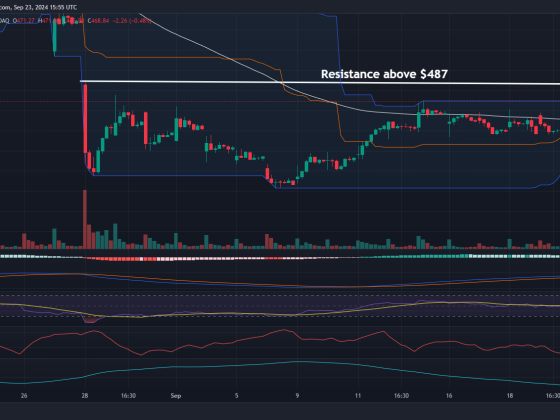Microsoft Corp. (NASDAQ: MSFT) faced a shift in analyst sentiment on Monday, September 23, as DA Davidson downgraded the tech giant from a Buy to a Neutral rating while maintaining a $475 price target.
The downgrade stems from concerns that Microsoft’s competitive edge in artificial intelligence (AI) is waning due to intensified competition from industry giants like Amazon.com Inc. (NASDAQ: AMZN) and Alphabet Inc.’s Google (NASDAQ: GOOGL).
Analyst Gil Luria of DA Davidson highlighted that Amazon Web Services (AWS) is now adding cloud business at a pace comparable to Microsoft’s Azure after several quarters.
Google Cloud has also experienced accelerating growth, narrowing the gap with Azure.
Luria pointed out that Amazon and Google are “far ahead” in deploying custom silicon in their data centers, whereas Microsoft remains heavily reliant on NVIDIA Corp. (NASDAQ: NVDA) for AI-focused chips.
This dependency could result in Microsoft shifting wealth from its shareholders to NVIDIA’s, especially as operating margins are expected to decline due to increased capital expenditures from 12% to 21% of revenue.
Microsoft stock: majority of analysts remain bullish
Despite DA Davidson’s cautious stance, other analysts maintain a bullish outlook on Microsoft.
Mizuho Securities recently reiterated its Outperform rating and a $480 price target, following Microsoft’s announcement of a 10.7% increase in its quarterly dividend to $0.83 per share and a new $60 billion share repurchase program.
Analyst Gregg Moskowitz emphasized that Microsoft’s medium-term revenue growth opportunities are larger than many investors realize, driven by tangible generative AI adoption and its monetization potential.
Morgan Stanley echoed this optimism, reaffirming an Overweight rating and a $506 price target. Analyst Keith Weiss noted that Microsoft’s substantial buyback program and dividend hike underscore its “attractive” total return profile.
He added that the company’s commitment to returning value to shareholders, combined with mid-teens earnings per share growth, supports a strong total return potential.
Recent developments around Microsoft stock
In recent strategic moves, Microsoft appointed Carolina Dybeck Happe as Executive Vice President and Chief Operations Officer.
Happe brings extensive experience from her previous role as Chief Financial Officer at General Electric Co. (NYSE: GE), where she played a crucial role in the company’s turnaround and debt reduction efforts exceeding $100 billion.
On the sustainability front, Microsoft signed a 437.6 MW green attribute contract with Indian renewable energy company ReNew (NASDAQ: RNW) to advance its ambition to be carbon-negative by 2030.
The company is also partnering with Constellation Energy (NASDAQ: CEG) to restart part of the Three Mile Island nuclear power plant. This move aims to secure more reliable and carbon-free energy sources to meet the growing electricity demands driven by AI technology.
Microsoft’s Intelligent Cloud: a growth driver
Financially, Microsoft’s Intelligent Cloud segment continues to be a robust growth driver.
In fiscal year 2024, the segment generated $105.3 billion in revenue, marking a 19% year-over-year increase.
However, the company anticipates a slowdown in this segment for the first quarter of fiscal 2025, projecting revenues between $23.8 billion and $24.1 billion, with expectations of a rebound in the second half of the fiscal year.
Microsoft stock: valuation
In terms of valuation metrics, Microsoft’s stock is trading at a price-to-earnings (P/E) ratio of 36.8x, compared to the peer group average of 29.0x.
The enterprise value to 2024 sales ratio stands at 12.3x, higher than the peer average of 7.3x.
While these figures suggest a premium valuation, many analysts believe that Microsoft’s strong positioning in AI and cloud computing justifies the higher multiples.
Market sentiment remains largely positive, with 56 out of 58 analysts rating the stock as a Buy and a median price target of $500.
The company’s strategic investments in AI, cloud infrastructure, and renewable energy, along with shareholder-friendly initiatives like dividend hikes and share repurchases, reinforce its long-term growth prospects.
However, the increased competition in AI and cloud services presents challenges.
Microsoft’s reliance on NVIDIA for AI chips and the substantial capital expenditures required for data center expansion could impact profitability.
As Microsoft’s narrative unfolds, it’s essential to analyze not just its fundamental strengths and market valuations but also the technical indicators that could influence its stock movement.
With that in mind, let’s turn our attention to the charts to explore the stock’s price trajectory and identify potential investment opportunities.
Microsoft stock: short-term weakness emerges
Microsoft experienced a strong uptrend starting in 2023, leading the stock to double in value.
While long-term charts remain bullish, the momentum has softened in recent weeks.
Source: TradingView
After hitting an all-time high of $467.70 in early July, the stock dipped below $400 in August.
Though it has since recovered, short-term charts still show weakness.
For bullish investors, caution is advised. Those looking to enter should wait for a daily close above the recent swing high of $448.70 before considering new positions.
Meanwhile, traders with a bearish outlook may consider initiating a small short position around current levels, setting a stop loss at $452.
If the stock drops below $428, they can add to their short positions.
The post Microsoft downgraded by DA Davidson citing AI competition: time to sell? appeared first on Invezz


